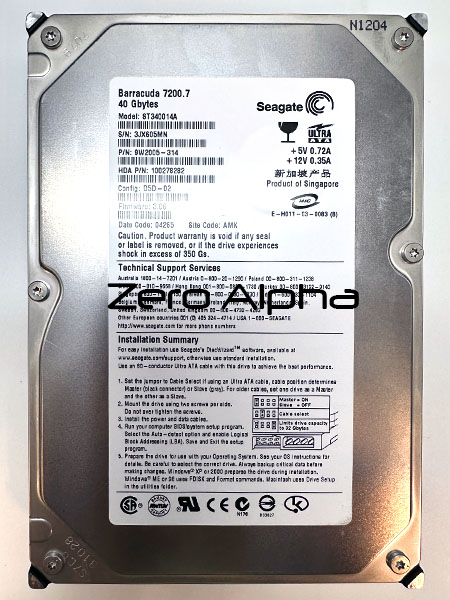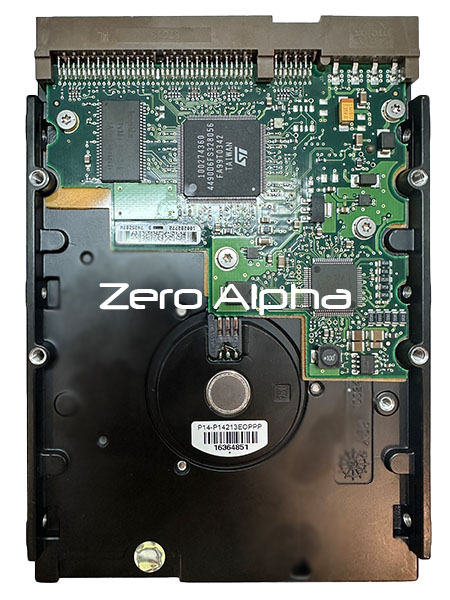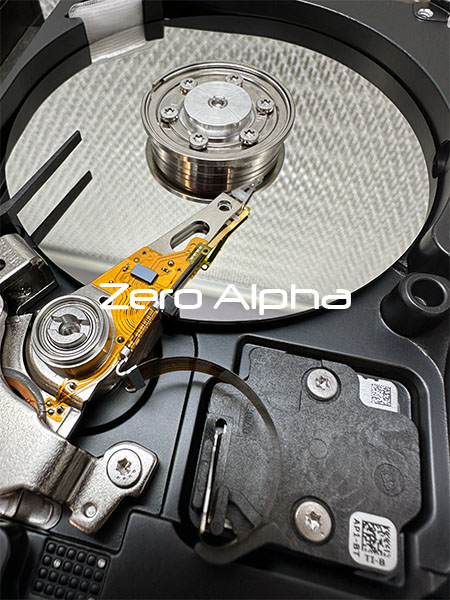Seagate ST340014A Data Recovery
The Seagate ST340014A is a 40GB IDE hard drive that was widely used in desktop systems during the early 2000s. While these drives were once considered reliable, their age has now made them highly susceptible to failure. At Zero Alpha Data Recovery, we continue to receive these legacy drives for recovery, and they typically present several serious issues.

Common problems with Seagate ST340014A
1. Stiction (Heads Stuck to Platters)
One of the most common problems with the ST340014A is stiction, where the read/write heads become physically stuck to the platter surface. This often happens after a period of inactivity or improper shutdown. Attempting to power on the drive repeatedly in this state can cause permanent damage to the heads or platter surface.
2. Spindle Motor Seizure
With age, the spindle motor in these drives can seize due to bearing failure or lubricant degradation. A seized motor prevents the platters from spinning, rendering the drive completely inoperable. Recovery in such cases requires disassembly in a cleanroom environment and the use of donor parts.
3. Failed Read/Write Heads
Mechanical wear and tear on the read/write heads is common in drives of this vintage. A failed head can lead to clicking sounds or cause the drive to hang during detection. In many cases, one or more heads must be replaced using parts from a compatible donor drive.
4. Bad Sectors and Media Degradation
After two decades of use or storage, platter degradation is expected. Drives may exhibit high numbers of bad sectors, often in key system areas such as the partition table or file system structures. Attempting to clone or image the drive without specialized tools may worsen the damage and reduce the chances of a successful recovery.
5. Firmware Corruption
Firmware stored on the drive’s platters can become corrupted over time. If critical firmware modules—such as the adaptive parameters or translator—are damaged, the drive may fail to initialize properly or report an incorrect capacity. Specialized tools are required to access and rebuild these firmware modules manually.
6. Printed Circuit Board (PCB) Failures
Due to their age, many ST340014A drives suffer from PCB-related issues such as burnt components, degraded capacitors, or corroded solder joints. Since Seagate embeds drive-specific adaptive data in the ROM, simply swapping the board is not a viable solution without extracting and transferring this information.

Seagate ST340014A Data Recovery Caselog

15Apr25: Old Hard drive on Windows-2000. Stuck in the BSY state.Spins sounds ok.Let it sit for 5 minutes again and it id with master.We went to task to clone it-sounds scratchy. Connected to the terminal without jumper and it comes up with output but I can not do anything through terminal. IDs. Drive is in poor condition. No terminal input but does print. Tried safe mode and ldr but drive gets stuck busy. Spins up and says "Error Reading Reserve Track Defect List" with F> prompt
Terminal works. drive comes ready faster if you spam "." key in terminal after power on. Family: alpine 7200.7.
"." spam maybe not required. terminal was on a weird angle and behaves better after laying flat. we might need to replace a cable
We were able to read a decent sized SA region - 0xF6B7 : 0x0 : 0x0 (0x280)
Trying LDR creation again.
Data ECC error reading app code.
Error code A3 is "Bad application code".
Seeing error code A1 and A2 too, which are "Reserve track defect list bad" and "Boot adaptives bad".
Drive was sometimes able to load stuff from SA, will let it rest.
Currently utility only gives safe mode access.
Drive only has one head, so there's only one copy of the service area.